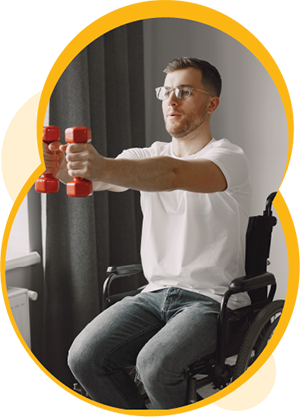Getting and staying active with arthritis
Many of us know that having the knowledge and skill to perform physical activity doesn’t always mean we will do it. And that’s understandable! There are many other factors that come into play, like:
-
 Motivation: What makes you want or decide to make a change in your lifestyle?
Motivation: What makes you want or decide to make a change in your lifestyle?
-
Enjoyment: What activities do you like to do? If it’s not something you enjoy, it’s much easier to skip it and harder to stick with it in the long term.
-
Opportunity: Is it easy for you to do an activity in terms of when, where, and how? You’ll likely be most successful if your activities are in an environment you’re comfortable in and can readily access, and if you’re doing them at a time of day where you feel you’re most limber and can focus. Timing of taking medications may also come into play.
-
Barriers: Are there other barriers to participating, like access to equipment, enough space, or is there a financial burden?
-
Symptoms: Some days you’ll feel better than others, in terms of pain and fatigue. How might your activities be modified based on your symptoms? For people with osteoarthritis, long walks or other exercises putting repeated stress on the affected joints might cause too much pain, while people with inflammatory arthritis may be too stiff in the morning to exercise.
There’s no one-size-fits all approach to success when it comes to changing your existing habits and patterns – which is what you’re asking yourself to do as you start a new physical activity routine. Here are some tips that can help:
-
Manage your expectations about starting something new, which is rarely easy. Remember that any movement helps.
-
 Set a goal. Do you want to reduce your sedentary time? Find a new physical activity you like to do? Strengthen your muscles? Become more flexible? Once you know what you want to do, try to identify why you want to do it, and set it as a goal. An example could be, “I want to spend more time in nature (why), so I am going to take a walk outside three evenings a week after dinner (what)". Goals can help you gain control of your lifestyle. Try to be specific and realistic. Focus on one change at a time.
Set a goal. Do you want to reduce your sedentary time? Find a new physical activity you like to do? Strengthen your muscles? Become more flexible? Once you know what you want to do, try to identify why you want to do it, and set it as a goal. An example could be, “I want to spend more time in nature (why), so I am going to take a walk outside three evenings a week after dinner (what)". Goals can help you gain control of your lifestyle. Try to be specific and realistic. Focus on one change at a time.
-
Make a plan. How will you get to that goal, and how will you know if you’re succeeding? Break it down into small, more manageable steps.
-
Monitor your progress. Plan to check in with yourself after a few months to reflect on how things are going. Celebrate your achievements, no matter how small, and consider whether any part of your plan needs to change.
-
Be kind to yourself. If you lose motivation or have trouble establishing healthy habits, recognize that changing behaviour is hard for everyone. It will take time and you can always return to your goals and plan, adapting them as you learn more about what works for you, and what doesn’t. If you discovered you didn’t like the activity you chose as much as you thought, switch it up and try something else.
-
Consider exercising with a friend or monitoring progress with a healthcare or exercise professional if that motivates you to keep on track.
